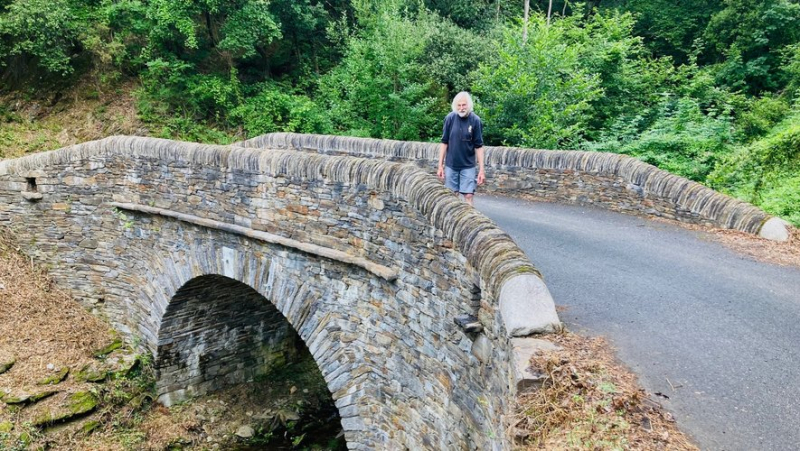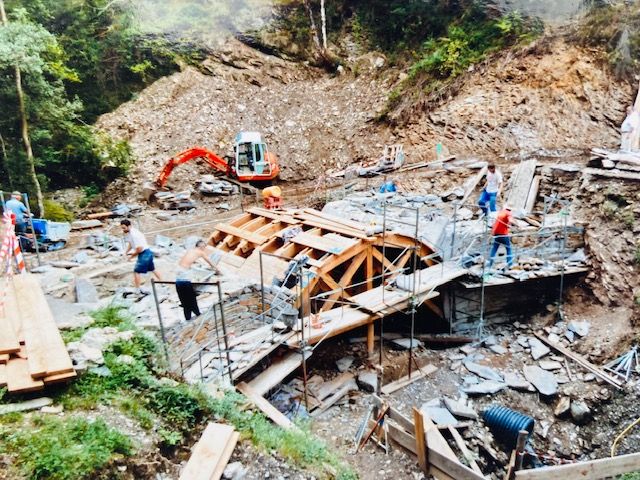The Chaldecoste bridge, an example of dry stone construction made from schist from local quarries

Marc Dombre sur le pont qu'il a réalisé avec ses compagnons bâtisseurs. MIDI LIBRE – M .P
Cet été, quatre épisodes font découvrir de fabuleux ponts patrimoniaux lozériens.
It is a road bridge in Ventalon-en-Cévennes (formerly Saint-Andéol-de-Clerguemort), on the road to Lézinier, in the heart of the Cévennes National Park (PNC). In 2008, after the collapse of the concrete ford following a flood of the stream, the mayor at the time Camille Lecat and his municipal council took the initiative to build a real bridge. With the particularity of using plans dating from the 19th century, all with local schist. Marc Dombre, a former dry stone builder in the Cévennes and a founding member of the Association of Dry Stone Builders, led the operation with three other friends.

In the background, the 16th century mule bridge, still standing. MIDI LIBRE – M. P
The specialist recalls the history of the ford, in a bend in the valley, where an old mule bridge from the middle of the second millennium still stands, a few meters from the current one: “The origin is there. Over time, the width of the vehicles required the construction of a concrete ford, which was washed away each year." Hence the desire to erect a real building. Camille Lecat then contacted the dry stone builders' school, a few kilometers away, on the Route des Crêtes: "We were obviously up for it and we were selected", remembers Marc Dombre.
A semicircular arch six meters in diameter, a submerged part that takes its base on the rock, everything is then traced with a chalk line: “It's only stone and lime mortar”, smiles Marc Dombre. A wooden structure is built to create the arch, the keystone that can support the entire structure, the hedgehog parapets: “The schist comes from the David Rocher quarries in Saint-Julien-du-Tournel and Lachamp”, explains the builder.
An economic and ecological interest
It took three months of preparation to cut the stones, the voussoirs, advance:“During the summer, there were about a dozen of us working. The bridge had to be built before a flood, which would have swept everything away”, remembers Marc Dombre. Once the structure was built, the scaffolding and structure were removed before the road was tarmacked and the parapets were built. “In all, this represented 1,050 days of work between June 2011 and February 2012, 250 m3 of loose stones, or 600 tonnes, 95 tonnes of sand and 600 bags of lime, 8 m3 of homemade framework, proudly announces the Cévenol. We had a great time."

The wooden arch to support the structure at the time of the construction of the vault DR
The pride of a job well done is real and the economic and ecological impact of the achievement has been beneficial: “Near here, another bridge has been built, with a concrete solution, with two huge earthmoving machines. It cost twice as much as ours. We only had a mini-excavator, a small crawler transporter and a cement mixer." All the stones were laid "on contact", the lime mortar "at discretion" to fill the gaps. Marc Dombre's only fear is the fall of a tree: “It is necessary to prune regularly.”
Read also: The Salièges bridge in Florac-Trois-Rivières awaits restoration to revive its ancestral stones
Read also: The Ussel footbridge in Auroux, in the heart of Margeride, a testimony to the restoration of local heritage
Numerous heritage awards have been given to this work of art, with the guarantee of a century-long life, almost without maintenance, according to the life cycle analysis. Well-established at the bottom of its Cévennes valley, the Chaldecoste bridge is ready to face the future.
The Espinas relay, a nice break on the crest route
The Espinas relay is an essential stop to make, on the crest road, between Mende and Alès (RD35), before going to discover the remarkable Chaldecoste bridge, a few kilometers away. Just opposite the relay, simply cross the departmental road to discover the administrative and teaching buildings and the remarkable small museum of the school of dry stone builders (Abps). But on this side of the road, there is no question of assembling low walls. Make way for the pleasure of discovering, from the terrace, a unique view of the Cévennes. For a drink and (or) something to eat.
“I have been managing this place for about ten years, explains Camille Lecat. It is a cooperative restaurant of collective interest where we also welcome associations. We provide cultural activities, another linked to the chestnut grove, which provides training in particular.”
Simple, friendly and nice
Open from February 15 to December 15, the bar restaurant reaches full capacity in the summer, with non-stop lunch and dinner. “It's a place born from a local desire, to have a meeting point to break the isolation in the hamlets. It's simple, friendly and nice”, smiles the manager. As for the catering, the dishes are divinely served and delicious: “We have a local and leisure clientele, without a single menu. We do everything ourselves”, insists Camille Lecat. A cuisine inspired by inspiration, “which adapts”. Some evenings, it's happy hours around the bar, “boards, fries and homemade mayonnaise” and other dates provide concerts or shows. And what could be more pleasant, at sunset, than to appreciate this life in the Cévennes. Quiet.
To find out everything about the place: lerelaisdelespinas.org

The great team of the Espinas relay on the RD35. MIDI LIBRE – M. P
I subscribe to read the rest




